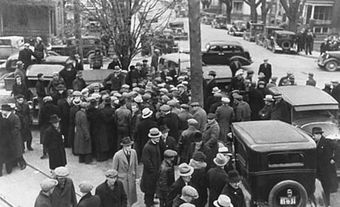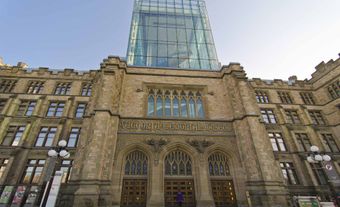Oshawa, ON, incorporated as a city in 1924, population 159,458 (2016 census), 149,607 (2011 census). The city of Oshawa is located 52 km east of Toronto on Lake Ontario. Originally called Skae's Corners, its present name is an Ojibwa term meaning “that point at the crossing of the stream where the canoe was exchanged for the trail.” In 1974, Oshawa became part of the newly formed Regional Municipality of Durham.
Settlement and Development
Oshawa’s initial function as a transportation centre was based on its excellent harbour, good road connections and the Grand Trunk Railway, which was completed in 1856 from Toronto to Montreal. Manufacturing soon took precedence. Especially notable was the Oshawa Manufacturing Company, owned by Joseph Hall, who developed it into the largest producer of agricultural implements in Canada.
General Motors of Canada
McLaughlin Carriage Works, developer of the McLaughlin-Buick automobile, soon became Oshawa’s dominant manufacturer. In 1918, the McLaughlin Motor Car Company and the Chevrolet Motor Car Company of Canada were merged into General Motors of Canada Ltd(GM). Local entrepreneur Robert S. “Colonel Sam”McLaughlin as president.
In the years that followed, GM became the dominant employer, but after several years of poor labour relations, it was the target of a major strike in 1937. GM workers certified the United Automobile Workers (UAW), an industrial union affiliated with the American-based Committee for Industrial Organization (CIO; later Congress of Industrial Organization). Much to the chagrin of Ontario's premier, Mitchell Hepburn, who hoped the UAW would lose the strike, the union, despite the use of special police, established itself as a force in Canadian labour (see also Politics in Ontario).
Economy
For over a century, the automotive industry was the principle employer in Oshawa. However, major issues began to arise due to outsourcing. Outsourcing is the practice of ordering materials formerly produced at the General Motors plant from offsite suppliers, which are often non-union and pay lower wages. This issue became the focus of a strike at Oshawa's GM plant in 1996, where an agreement was reached to provide a model for contracts with Chrysler and Ford.
In 2018, GM announced the Oshawa plant would cease production by the end of 2019, affecting 2,973 employees, 2,522 of whom work at the plant. Unifor, the union representing those at the plant earning hourly wages, fought against the slated closure. Their campaign included a call for a partial boycott GM vehicles and a Super Bowl ad against the company. In May 2019, GM announced that while the plant will still stop producing vehicles, a portion of the factory will remain open in order to test autonomous vehicles and perform other tasks.
The decline of the automotive industry has led to the rise of other sectors in Oshawa, including health and education.
Cultural Life
Oshawa is home to Durham College, part of Ontario's network of Colleges of Applied Arts and Technology. There are also several museums: Canadian Automotive Museum, Oshawa Aeronautical Military and Industrial Museum and Robert Stuart Aeronautical Museum. The Oshawa Community Museum consists of three historic homes featuring local historical artifacts. Parkwood Estate and Gardens, the 55-room mansion which was the home of Robert Samuel McLaughlin, is a national historic site.
The Robert McLaughlin Gallery features changing exhibits of works by Canadian artists. Downtown, nine buildings have been adorned with murals depicting Oshawa's history and multicultural diversity. Other attractions include Oshawa Trails along the Oshawa and Harmony Creek valleys, the Lake Ontario waterfront and McLaughlin Bay Wildlife Reserve. Oshawa has a symphony orchestra and numerous sports and recreational facilities.
Prominent Oshawans include Michael Starr, Cabinet minister in the Diefenbaker government; Edward Broadbent federal leader of the New Democratic Party; and Donald Jackson, world figure skating champion.

 Share on Facebook
Share on Facebook Share on X
Share on X Share by Email
Share by Email Share on Google Classroom
Share on Google Classroom


